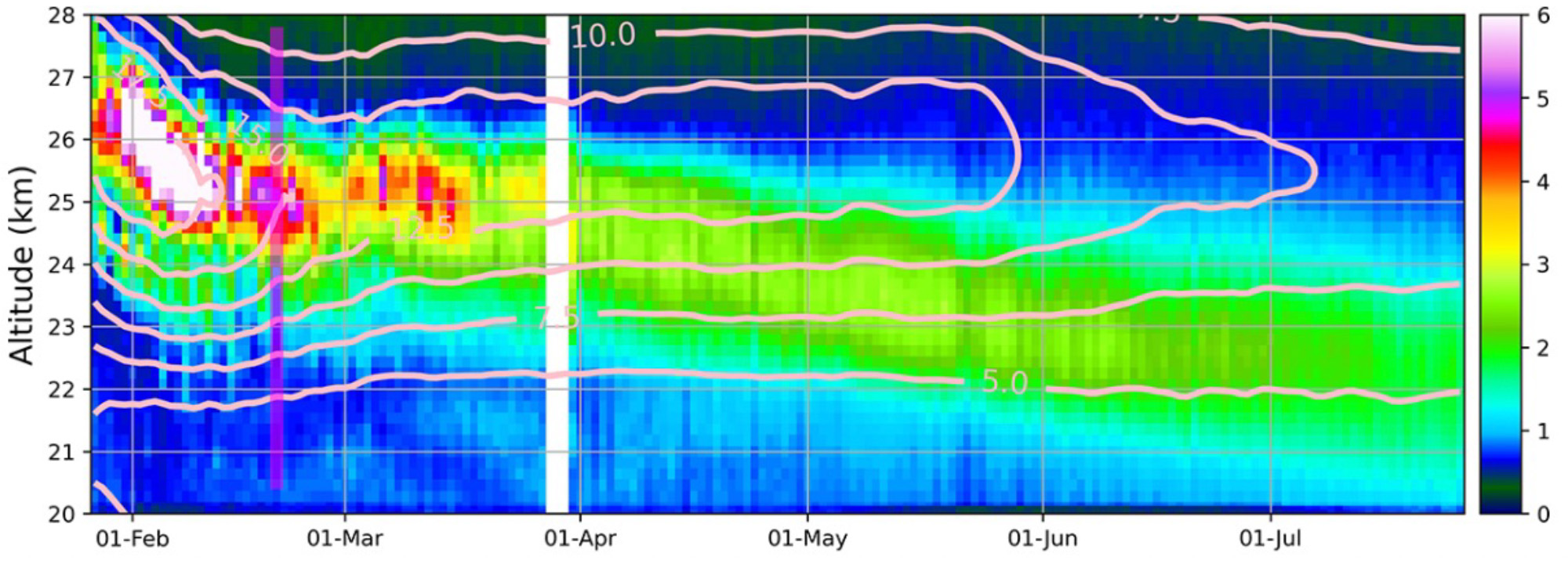The January 15, 2022 eruption of the Hunga Tonga-Hunga Ha’apai (HT-HH) underwater volcano sent a volcanic plume into the middle atmosphere to altitudes of up to 57 km, injected ~150Tg of water vapor, and resulted in the largest stratospheric aerosol perturbation since the Pinatubo eruption.
Measurements from the Aura Microwave Limb Sounder (MLS), Cloud-Aerosol Lidar with Orthogonal Polarization (CALIOP), as well as from the Ozone Mapping and Profile Suite (OMPS, not shown) revealed that a distinct aerosol and water vapor layer formed in the stratosphere. Until late February, the water vapor plume coincides with that of the aerosols, but the plumes progressively move apart vertically after that date, with the aerosol plume sinking below the water vapor. These distinct layers persisted at least until the end of July, while slowly moving apart in altitude.
Perturbations in stratospheric aerosol and water vapor have the potential to significantly impact the climate system in opposing ways. Several studies have proposed that, due to its larger and more persistent water vapor plume, HT-HH will have a net surface warming effect.

Zonal and latitude band averages (25oS-15oS) as a function of time for CALIOP 532 nm scattering ratio (color) and MLS water vapor (contours, ppmv).
Data Sources:
OMPS-LPV2.1 data are available
Aura MLS Level 2 data are available
CALIOP data v3.41 are available
Technical description of figure:
Adapted from Figure 3 panel c of Legras et al (2022). This panel shows zonal and latitude band averages as a function of time for CALIOP 532 nm scattering ratio (color) and MLS water vapor (contours, ppmv) for the 25oS–15oS latitude band.
Scientific significance, societal relevance, and relationships to future missions:
MLS measurements uniquely reveal that an exceptional amount of water vapor was injected directly into the stratosphere by the HT-HH eruption. CALIOP and OMPS measurements show that this eruption led to the largest stratospheric aerosol perturbation in the last three decades. Several studies suggest that, unlike previous strong eruptions in the satellite era, the HT-HH climate impact could be dominated not by surface cooling due to sulfate aerosols, but rather by surface warming due to the larger greenhouse effect of water vapor.
The results of these studies underscore the critical need for continued monitoring of vertically resolved profiles of stratospheric aerosols and water vapor. Aerosols are currently monitored by OMPS and CALIOP, and there are new aerosol measurements in the pipeline. MLS is the only sensor providing daily near-global profiles of humidity from the upper troposphere to the mesosphere. After MLS is decommissioned, only solar occultation sensors will measure water vapor at these levels, giving only ∼monthly global coverage.
References:
Legras, B., Duchamp, C., Sellitto, P., Podglajen, A., Carboni, E., Siddans, R., Grooß, J.-U., Khaykin, S., and Ploeger, F.: The evolution and dynamics of the Hunga Tonga–Hunga Ha'apai sulfate aerosol plume in the stratosphere, Atmos. Chem. Phys., 22, 14957–14970, doi:10.5194/acp-22-14957-2022, 2022.
Schoeberl, M. R., Wang, Y., Ueyama, R., Taha, G., Jensen, E., & Yu, W.: Analysis and impact of the Hunga Tonga-Hunga Ha'apai stratospheric water vapor plume. Geophysical Research Letters, 49, e2022GL100248. doi:10.1029/2022GL100248, 2022..
01.2023